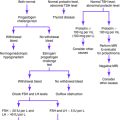Chapter 41 VAGINAL DISCHARGE
Vaginal discharge is a common complaint of women and can either be physiologic or pathologic. Physiologic discharge is usually white or clear and thin and may have a mild odor. Accompanying symptoms such as itching, burning sensation, and redness should not be present. A woman’s vaginal discharge can change with the menstrual cycle. In addition, vaginal discharge may change as a woman ages and during pregnancy.
Medications That Can Affect Vaginal Discharge
Antibiotics (increases risk for candidiasis)
Antiseptics (may cause chemical irritation or allergic vaginitis)
Corticosteroids (increases risk for candidiasis)
Lubricants (may cause chemical irritation or allergic vaginitis)
Oral contraceptives (increase risk for candidiasis and may affect discharge as a result of estrogen effect)
Over-the-counter vaginal creams (may cause chemical irritation or allergic vaginitis)
Spermicides (may cause chemical irritation or allergic vaginitis)
Causes of Vaginal Discharge
Allergic or irritant vaginitis (deodorant, douches, spermicides, semen)
Anaerobic infections caused by foreign bodies (tampons, condoms, diaphragms)
Desquamative inflammatory vaginitis
Mycoplasma genitalium infection
Physiologic discharge (pregnancy, menstrual cycle)
Staphylococcus aureus infection
Key Historical Features
✓ Duration, color, consistency, amount, and odor of discharge
✓ Associated symptoms, such as burning sensation, itching, bleeding, pelvic or abdominal pain, lesions, dysuria, or painful sexual intercourse
✓ History of gynecologic surgery
✓ History of sexually transmitted diseases or vaginitis
✓ History of abnormal Pap smear results
✓ History of pelvic radiation therapy (which increases risk for fistula)
✓ Most recent menstrual period
✓ Contraceptive used (condoms, intrauterine device)
✓ Obstetric history, including history of obstetric trauma (increases risk for fistula)
Key Physical Findings
✓ Vital signs, especially assessment for the presence of fever
✓ External genital examination
✓ Bimanual examination to evaluate for cervical motion or uterine or adnexal tenderness, which is suggestive of pelvic inflammatory disease
Suggested Work-Up
| Wet-mount preparation of cervical discharge | To detect trichomonads (trichomonas) or clue cells (bacterial vaginosis), polymorphonuclear leukocytes (a ratio of polymorphonuclear leukocytes to epithelial cells greater than 1:1 is seen with T. vaginalis infection, gonorrhea, chlamydia, and herpes simplex), or round parabasal cells (which are seen with atrophic vaginitis) |
| Potassium hydroxide (KOH) preparation | To detect candidal infections (pseudohyphae or budding yeast) |
| Whiff test | To detect bacterial vaginosis (fishy odor with KOH) |
| Measurement of pH | A pH greater than 4 could indicate bacterial vaginosis or T. vaginalis infection (normal vaginal pH is 3.8 to 4.2) |
| Pap smear | To evaluate for cervical dysplasia |
| Endocervical swab or urine nucleic acid amplification test for Chlamydia organisms and N. gonorrhoeae (endocervical swab or urine) | To detect infections by these organisms |
Additional Work-Up
| Urine pregnancy test | If pregnancy is suspected |
| Sabouraud medium or Nickerson agar culture | To evaluate for candidal infections if the diagnosis is unclear |
| Diamond medium culture or polymerase chain reaction (PCR) testing | To evaluate for T. vaginalis infection if the diagnosis is suspected and wet-mount test is negative |
| Gram stain of cervical discharge | For the presence of intracellular gram-negative diplococci, which indicates gonorrhea, if an immediate diagnosis is needed |
| Viral culture of herpetic lesions | If herpes simplex infection is suspected |
| Biopsy | To evaluate lesions that appear to be neoplastic |
| Colposcopy | To evaluate suspicious lesions on the cervix |
| Thayer-Martin agar culture of cervical discharge | To evaluate for gonorrhea |
| HIV test | If the patient is at risk for HIV infection |
| Chlamydia culture of cervical discharge | If chlamydial infection is suspected |
Egan ME, Lipsky MS. Diagnosis of vaginitis. Am Fam Physician. 2000;62:1095-1104.
Fox KK, Behets F. Vaginal discharge: how to pinpoint the cause. Postgrad Med. 1995;989:87-104.
Henn EW, Kruger TF, Siebert TI. Vaginal discharge reviewed: the adult pre-menopausal female. S Afr Fam Pract. 2005;47(2):30-31.
Mitchell H. Vaginal discharge—causes, diagnosis, and treatment. BMJ. 2004;328:1306-1308.
Owen MK, Clenney TL. Management of vaginitis. Am Fam Physician. 2004;70:2125-2132.




